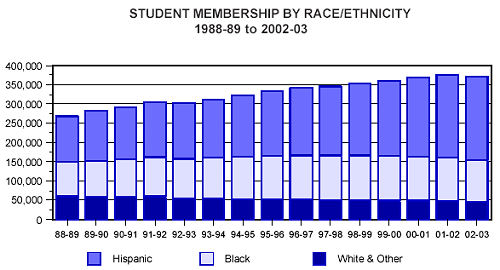The Miami-Dade Public County School
district is the 4th largest in the country with over 338 thousand
students and over 19 thousand teachers.15
Like many
other school districts in urban areas around the country, the system
has problems. The Beacon Council, an organization devoted to
economic development in Miami, has
identified some of the many obstacles to creating a strong
education
system:
- Socioeconomic
Factors- 24% of children entering kindergarten come from
families living below the poverty level.16
Families living below the poverty level often become excessively
burdened with financial concerns. Oftentimes, parents become
forced to spend all their
time working and are not able to help children with schoolwork.
It may become more difficult for parents living under the poverty level
to support their children the same way parents who do not have to
deal with economic hardships are able to. One might speculate
that this puts their children
at a disadvantage in public schools.
- Language -
57.67% of public school students have a home
language other than English Many of these students speak Spanish,
Portuguese or Creole, in total over 118 foreign languages are spoken by
Greater Miami students.17
While many school districts nationally strive to achieve diversity, it
also can be a factor which makes public education difficult to
coordinate. With limited government funds, how can school
districts
reach out to students from all different backgrounds speaking different
languages?
- Overcrowding
- "Many of our public schools are critically overcrowded,
resulting in an inferior learning environment for students. Greater
Miami also has a high mobility factor, making it more likely that a
student's school year will be disrupted."18
Miami-Dade County
published the results of a 2002-2003 study which shows the student
population in terms of ethnicity from
1988 until 2003 (see below).

This chart shows not only a growing
student population which makes the overcrowding problem continue and
worsen, but also a growing Latino population, mirroring the national
trend. This is important because it shows the increasing number
of students who will be able to speak Spanish. Also important to
note: the decreasing "White and Other" population. It is not
simply
the percentage of whites decreasing, but the actual number, despite the
fact that the population is growing.
What does this say about the education
system? Well, the decrease in Caucasian enrollment may signify
that the schools are in fact reaching out more to the majority Latino
communities than to "Whites and Others". The fact that the Latino
population continues to grow may be a result of this effort to reach
out to the community, but more likely is due to the steady influx of
immigrants coming from Spanish-speaking countries.

